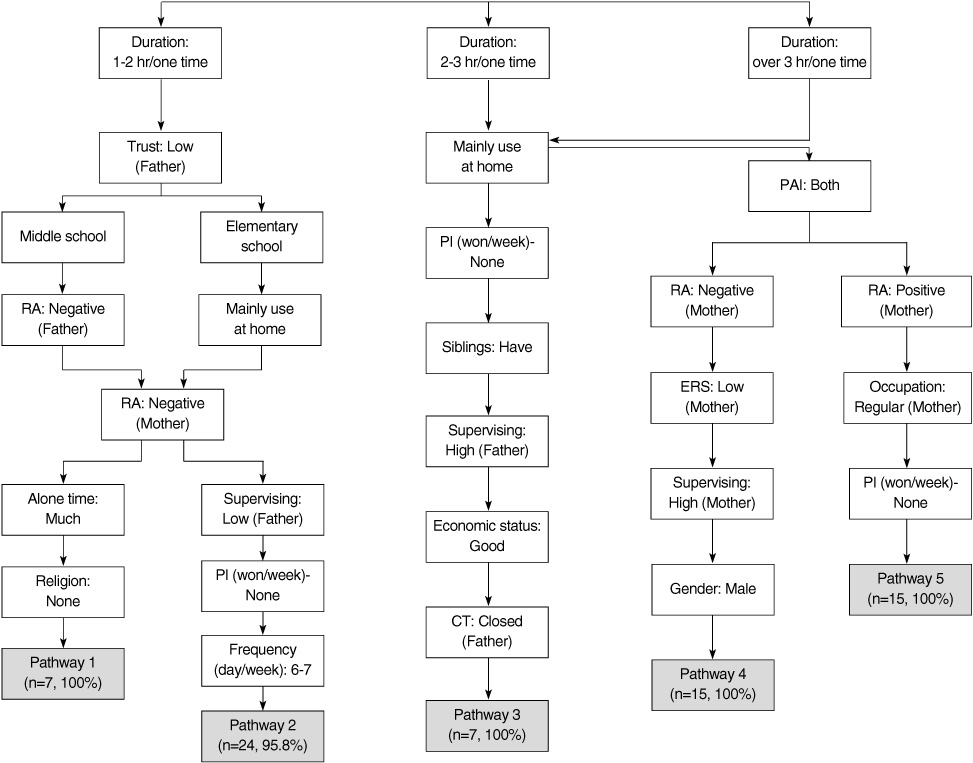J Korean Acad Nurs.
2010 Jun;40(3):378-388. 10.4040/jkan.2010.40.3.378.
A Prediction Model for Internet Game Addiction in Adolescents: Using a Decision Tree Analysis
- Affiliations
-
- 1College of Nursing, Ajou University, Suwon, Korea.
- 2Department of Nursing, Chung-Ang University, Seoul, Korea. kyung@cau.ac.kr
- KMID: 987585
- DOI: http://doi.org/10.4040/jkan.2010.40.3.378
Abstract
- PURPOSE
This study was designed to build a theoretical frame to provide practical help to prevent and manage adolescent internet game addiction by developing a prediction model through a comprehensive analysis of related factors.
METHODS
The participants were 1,318 students studying in elementary, middle, and high schools in Seoul and Gyeonggi Province, Korea. Collected data were analyzed using the SPSS program. Decision Tree Analysis using the Clementine program was applied to build an optimum and significant prediction model to predict internet game addiction related to various factors, especially parent related factors.
RESULTS
From the data analyses, the prediction model for factors related to internet game addiction presented with 5 pathways. Causative factors included gender, type of school, siblings, economic status, religion, time spent alone, gaming place, payment to Internet cafe, frequency, duration, parent's ability to use internet, occupation (mother), trust (father), expectations regarding adolescent's study (mother), supervising (both parents), rearing attitude (both parents).
CONCLUSION
The results suggest preventive and managerial nursing programs for specific groups by path. Use of this predictive model can expand the role of school nurses, not only in counseling addicted adolescents but also, in developing and carrying out programs with parents and approaching adolescents individually through databases and computer programming.
Keyword
MeSH Terms
Figure
Cited by 2 articles
-
Predictors of Protective Factors for Internet Game Addiction in Middle School Students using Data Mining Decision Tree Analysis
Young-Ran Kweon, Se-Young Kim
J Korean Acad Psychiatr Ment Health Nurs. 2014;23(1):12-20. doi: 10.12934/jkpmhn.2014.23.1.12.Development of a Quantitative Model on Adolescent Cyberbullying Victims in Korea: A System Dynamics Approach
Mi Jin You, Eun Mi Ham
J Korean Acad Nurs. 2019;49(4):398-410. doi: 10.4040/jkan.2019.49.4.398.
Reference
-
1. Ahn HS, Lee JS. Research of computer game immersion children's characters. Education Development Review. 2002. 23:57–87.2. Armsden GC, Greenberg MT. The inventory of parent and peer attachment: Relationships to well-being in adolescence. Journal of Youth Adolescence. 1987. 16:427–454.3. Bowlby J. Attachment and Loss, Vol, I: Attachment. 1969. New York, NY: Basic Books.4. Choi JH, Han ST, Kang HC, Kim ES, Kim MK, Lee SK. Data mining prediction and application. 2002. Seoul: SPSS academy.5. Jang HS. Adolescent-mother conflicts and their related variables. Korean Journal of Developmental Psychology. 2005. 18:97–113.6. Jo AM, Bang HJ. The effects of parent, teacher, and friend social support on adolescents game addiction. Korean Journal of Youth Studies. 2003. 10:249–275.7. Kheirkhah F, Juibary AG, Gouran A, Hashemi S. Internet addiction prevalence and epidemiological features: First study in Iran. European Psychiatry. 2008. 23:309.8. Kim HJ, Lee SJ, Woo JI, Jo HS, Kweon HJ. The internet using pattern and addiction-relating factor analysis of adolescents in Korea. Journal of the Korean Academy of Family Medicine. 2002. 23:334–343.9. Kim KS, Kim KH. Parent related factors in internet game addiction among elementary school students. Journal of Korean Academy of Child Health Nursing. 2009. 15:24–33.10. Kim SH. Internet Addiction, It can be cure by intensive care camp. Dong-A daily newspaper. 2008. 06. 16. A11.11. Kim YH. Construction of a model of internet-addicted adolescents mental health. 2006. Seoul: Chung-Ang University;Unpublished doctoral dissertation.12. Kim YH, Son HM, Yang YO, Cho YR, Lee NY. Relation between internet game addiction in elementary school students and student's perception of parent-child attachment. Journal of Korean Academy of Child Health Nursing. 2007. 13:383–389.13. Korea Agency for Digital Opportunity & Promotion [KADO]. A study of the development of internet game addiction scale for children and adolescents. 2006. Seoul: Author.14. Korea Agency for Digital Opportunity & Promotion [KADO]. Research of internet addiction family counsel program development. 2007. Seoul: Author.15. Korea Institute of Criminology [KIC]. Home environment and juvenile delinquency. 1995. Seoul: Author.16. Current state of internet use. Korea Internet & Security Agency [KISA]. 2009. Retrieved December 17, 2009. from http://isis.nida.or.kr/sub01/?pageId=010400.17. Kwon JH. The internet game addiction of adolescents: Temporal changes and related psychological variables. Korean Journal of Clinical Psychology. 2005. 24:267–280.18. Kwon YH. Construction of internet game addiction predictive model in adolescent. 2005. Daegu: Keimyung University;Unpublished doctoral dissertation.19. Lee HK. Effects of individual- and social-related factors and motives for game playing on game concentration and game addiction. Korean Journal of Youth Studies. 2003. 10:355–380.20. Lim EM, Lee SY. Adolescents' computer/internet use and parent-Adolescent conflict. Journal of Educational psychology. 2002. 6:243–258.21. Mitchell P. Internet Addiction: Genuine diagnosis or not? The Lancet. 2000. 355:632.22. Nam SH, Kim YH. Mother's psychological factors and young childrens's internalizing & externalizing malbehaviors. Journal of the Korea Home Economics Association. 2000. 38:199–213.23. Ok J. The relationship between attachment security and depression in adolescence: Focusing on the mediating effect of perceived competence. 1998. Seoul: Ewha Womans University;Unpublished master's thesis.24. Rae-Grant N, Thomas BM, Offrod DR, Boyle NM. Risk, protective factors and the prevalence of behavioral and emotional disorders in children and adolescent. Journal of American Academy of Child and Adolescent psychiatry. 1989. 28:262–268.25. Rohner RP, Rohner EC. Parental acceptance-rejection and parental control: Cross cultural coders. Ethnology. 1981. 20:245–260.26. Ryu JA. An analysis of ecological variables affecting adolescent internet addiction. 2003. Seoul: Sookmyung Women's University;Unpublished doctoral dissertation.27. Song SJ, Sim HO. Computer immersion and children's psychosocial/behavioral characteristics. Korean Journal of Child Studies. 2003. 24:27–41.28. Suh SY, Lee YH. The relationships between daily hassles, social support, absorption trait and internet addiction. Korean Journal of Clinical Psychology. 2007. 26:391–405.
- Full Text Links
- Actions
-
Cited
- CITED
-
- Close
- Share
- Similar articles
-
- Predictors of Protective Factors for Internet Game Addiction in Middle School Students using Data Mining Decision Tree Analysis
- The Effect of Stress on Internet Game Addiction Trends in Adults: Mindfulness and Conscientiousness as Mediators
- The Effectiveness of Game Coding Education on Problematic Internet Gaming
- Internet Addiction, Social Support and Psychological Factors in Adolescents
- Biological Model and Pharmacotherapy in Internet Addiction


